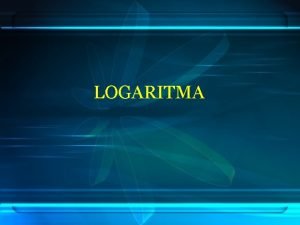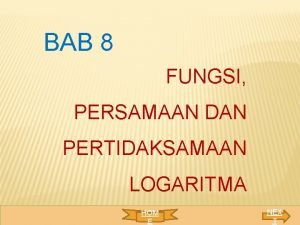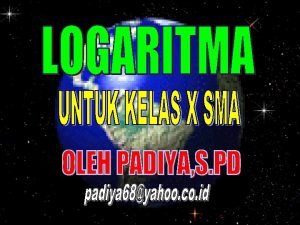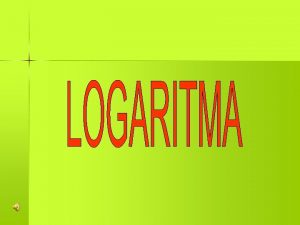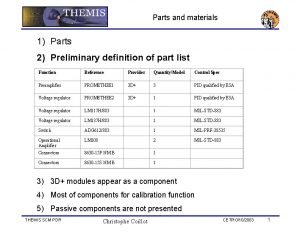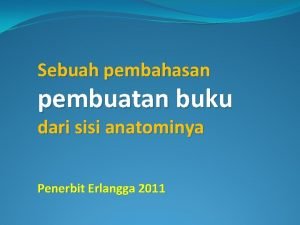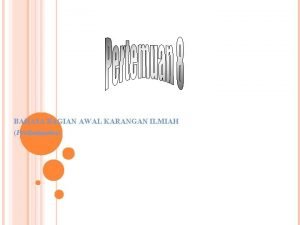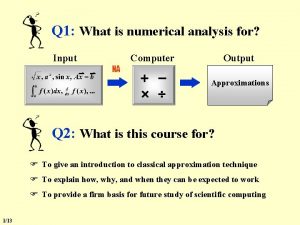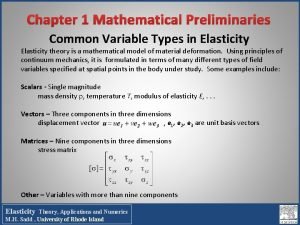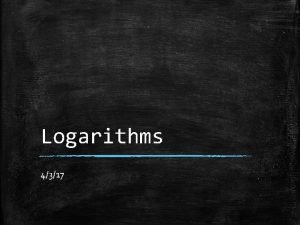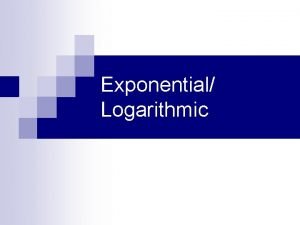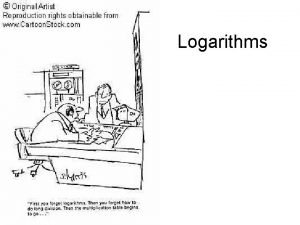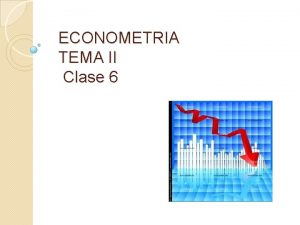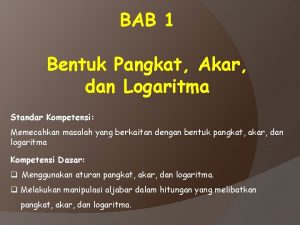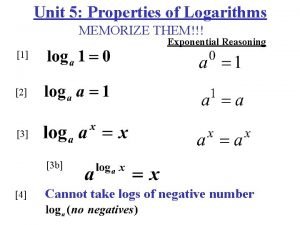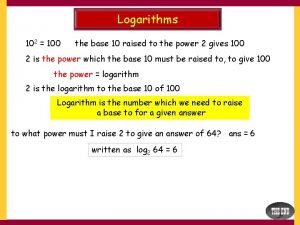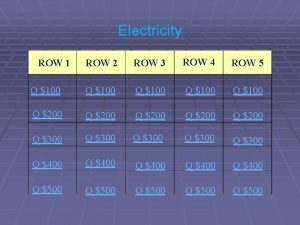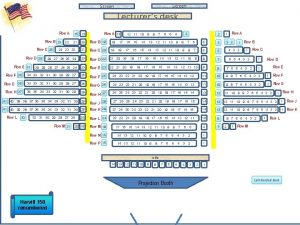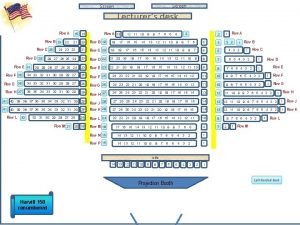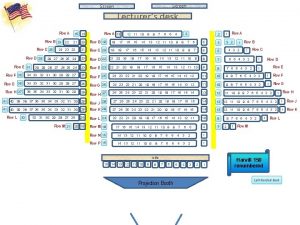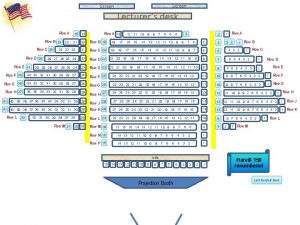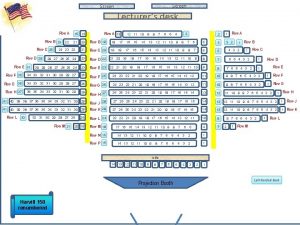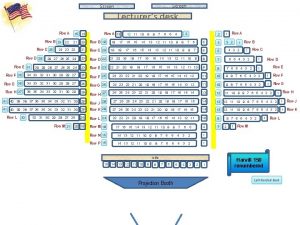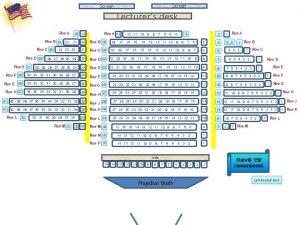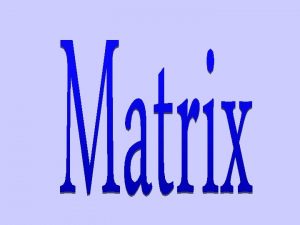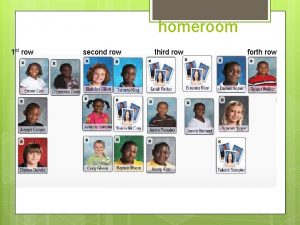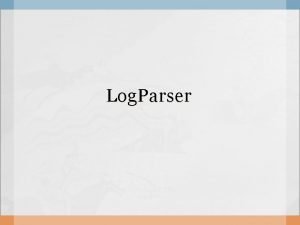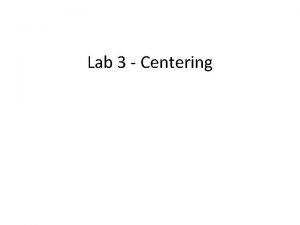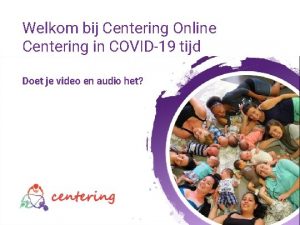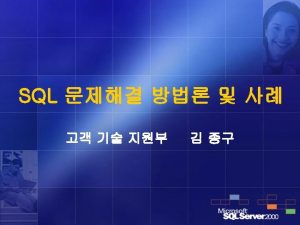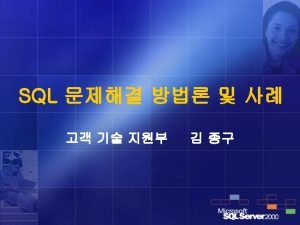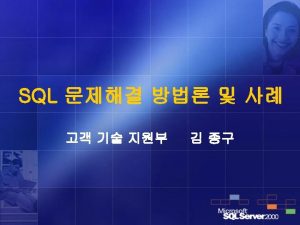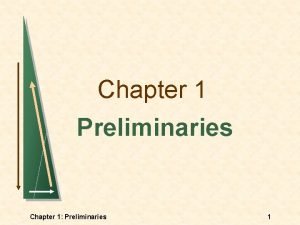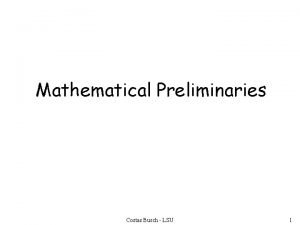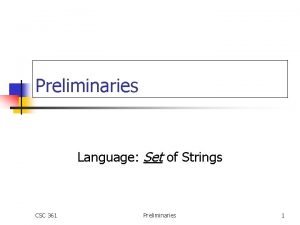Clustering Clustering Preliminaries Log 2 transformation Row centering






























- Slides: 30

Clustering

Clustering Preliminaries • Log 2 transformation • Row centering and normalization • Filtering

Log 2 Transformation Advantages of log 2 transformation: • Log 2 -transformation makes sure that the noise is independent of the mean and similar differences have the same meaning along the dynamic range of the values. – We would like dist(100, 200)=dist(1000, 2000).

Row Centering & Normalization x y=x-mean(x) z=y/stdev(y)

Filtering genes • Filtering is very important for unsupervised analysis since many noisy genes may totally mask the structure in the data • After finding a hypothesis one can identify marker genes in a larger dataset via supervised analysis. All genes Supervised Analysis Marker Selection Clustering

Clustering/Class Discovery • Aim: Partition data (e. g. genes or samples) into sub-groups (clusters), such that points of the same cluster are “more similar”. • Challenge: Not well defined. No single objective function / evaluation criterion • Example: How many clusters? 2+noise, 3+noise, 20, Hierarchical: 2 3 + noise • One has to choose: – Similarity/distance measure – Clustering method – Evaluate clusters

Clustering in Gene. Pattern • Representative based: Find representatives/centroids – K-means: KMeans. Clustering – Self Organizing Maps (SOM): SOMClustering • Bottom-up (Agglomerative): Hierarchical. Clustering Hierarchically unite clusters – single linkage analysis – complete linkage analysis – average linkage analysis • Clustering-like: – NMFConsensus – PCA (Principal Components Analysis) No BEST method! For easy problems – most of them work. Each algorithm has its assumptions and strengths and weaknesses

K-means Clustering • Aim: Partition the data points into K subsets and associate each subset with a centroid such that the sum of squared distances between the data points and their associated centroid is minimal.

K-means: Algorithm K=3 • Initialize centroids at random positions • Iterate: – Assign each data point to its closest centroid – Move centroids to center of assigned points • Stop when converged • Guaranteed to reach a local minimum 0 Iteration = 2 1

K-means: Summary • Result depends on initial centroids’ position • Fast algorithm: needs to compute distances from data points to centroids • Must preset number of clusters. • Fails for non-spherical distributions

Hierarchical Clustering Distance between joined clusters 4 2 5 3 1 1 3 2 4 Dendrogram 5

Hierarchical Clustering Need to define the distance between the new cluster and the other clusters. Single Linkage: distance between closest pair. Distance. Linkage: betweendistance joined clusters Complete between farthest pair. Average Linkage: average distance between all pairs 4 or distance between cluster centers 2 5 3 1 1 3 2 4 Dendrogram 5 The dendrogram induces a linear ordering of the data points (up to left/right flip in each split)

Average Linkage Leukemia samples and genes

Single and Complete Linkage Leukemia samples and genes Single-linkage Complete-linkage

Similarity/Distance Measures Decide: which samples/genes should be clustered together – Euclidean: the "ordinary" distance between two points that one would measure with a ruler, and is given by the Pythagorean formula – Pearson correlation - a parametric measure of the strength of linear dependence between two variables. – Absolute Pearson correlation - the absolute value of the Pearson correlation – Spearman rank correlation - a non-parametric measure of independence between two variables – Uncentered correlation - same as Pearson but assumes the mean is 0 – Absolute uncentered correlation - the absolute value of the uncentered correlation – Kendall’s tau - a non-parametric similarity measure used to measure the degree of correspondence between two rankings – City-block/Manhattan - the distance that would be traveled to get from one point to the other if a grid-like path is followed

Reasonable Distance Measure Euclidean distance on samples and genes on rowcentered and normalized data. Genes: Close -> Correlated Gene 1 Gene 2 Samples: Similar profile giving Gene 1 and 2 a similar contribution to the distance between sample 1 and 5 Gene 3 Gene 4 Sample 1 Sample 5

Pitfalls in Clustering • Elongated clusters • Filament • Clusters of different sizes

Compact Separated Clusters • All methods work Adapted from E. Domany

Elongated Clusters Ø Ø Single linkage succeeds to partition Average linkage fails

Filament • Single linkage not robust Adapted from E. Domany

Filament with Point Removed • Single linkage not robust Adapted from E. Domany

Two-way Clustering • Two independent cluster analyses on genes and samples used to reorder the data (two-way clustering):

Hierarchical Clustering Summary • Results depend on distance update method – Single Linkage: elongated clusters – Complete Linkage: sphere-like clusters • Greedy iterative process • NOT robust against noise • No inherent measure to choose the clusters – we return to this point in cluster validation

Clustering Protocol

Validating Number of Clusters How do we know how many real clusters exist in the dataset?

Consensus Clustering Consensus matrix: counts proportion of times two samples are clustered together. • (1) two samples always cluster together • (0) two samples never cluster together Original Dataset Generate “perturbed” datasets s 1 s 2 … sn . . . D 1 D 2 Dn Apply clustering algorithm to each Di Clustering 1 Clustering 2. . Clusteringn sn compute consensus matrix dendogram based on matrix The Broad Institute of MIT and Harvard

Consensus Clustering Consensus matrix: counts proportion of times two samples are clustered together. • (1) two samples always cluster together • (0) two samples never cluster together Original Dataset s 1 s 3 … . . . D 1 D 2 … si C 1 C 2 Dn Apply clustering algorithm to each Di Clustering 1 Clustering 2. . Clusteringn si compute consensus matrix C 3 dendogram based on matrix consensus matrix ordered according to dendogram

Validation Consistency / Robustness Analysis • Aim: Measure agreement between clustering results on “perturbed” versions of the data. • Method: – Iterate N times: • Generate “perturbed” version of the original dataset by subsampling, resampling with repeats, adding noise • Cluster the perturbed dataset – Calculate fraction of iterations where different samples belong to the same cluster – Optimize the number of clusters K by choosing the value of K which yields the most consistent results

Consensus Clustering in Gene. Pattern

Clustering Cookbook • Reduce number of genes by variation filtering – Use stricter parameters than for comparative marker selection • Choose a method for cluster discovery (e. g. hierarchical clustering) • Select a number of clusters – Check for sensitivity of clusters against filtering and clustering parameters – Validate on independent data sets – Internally test robustness of clusters with consensus clustering
 Is row, row your boat a binary form
Is row, row your boat a binary form Nilai dari 5log 10 + 5log 50 – 5log 4 adalah
Nilai dari 5log 10 + 5log 50 – 5log 4 adalah Jika log 3 = 0 477 dan log 5 = 0 699 nilai dari log 45 =
Jika log 3 = 0 477 dan log 5 = 0 699 nilai dari log 45 = Jika log 2=0 301
Jika log 2=0 301 Pertidaksamaan logaritma
Pertidaksamaan logaritma Jika log 5 = 0 699 nilai log 20 adalah
Jika log 5 = 0 699 nilai log 20 adalah Jika log 2 = 0 301 nilai log 32 =
Jika log 2 = 0 301 nilai log 32 = Nilai dari 2log 84 adalah
Nilai dari 2log 84 adalah ³log 243=
³log 243= Betty botter bought a bit of butter
Betty botter bought a bit of butter Single row and multiple row functions in sql
Single row and multiple row functions in sql Flat clustering vs hierarchical clustering
Flat clustering vs hierarchical clustering L
L Rumus euclidean distance
Rumus euclidean distance Parts of preliminaries
Parts of preliminaries Apa itu preliminaries
Apa itu preliminaries Tied synoynm
Tied synoynm Halaman preliminaries
Halaman preliminaries Mathematical preliminaries in numerical computing
Mathematical preliminaries in numerical computing Chapter 1 mathematical preliminaries
Chapter 1 mathematical preliminaries Centering and closing diphthongs
Centering and closing diphthongs Desmos log log
Desmos log log Log m-log n
Log m-log n Power law log log plot
Power law log log plot Log exp
Log exp Log multiply log
Log multiply log How do you get rid of ln
How do you get rid of ln Modelo log-log
Modelo log-log Pengertian pangkat, akar dan logaritma
Pengertian pangkat, akar dan logaritma Exponents properties
Exponents properties Log m - log n
Log m - log n

